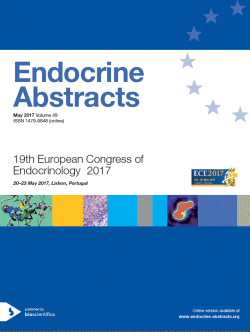Searchable abstracts of presentations at key conferences in endocrinology

19th European Congress of Endocrinology
Lisbon,
Portugal
20 May 2017 - 23 May 2017
20-23 May 2017, Lisbon, Portugal
Further information
Symposia
Environmental influences on endocrine systems
ea0049s21.1 | Environmental influences on endocrine systems | ECE2017
Lifestyle and environmental factors in metabolic diseases; endocrine disruptors: new diabetogens?
The prevalence of metabolic syndrome, obesity and type 2 diabetes has dramatically increased worldwide during the last few decades and exceeds World Health Organisations predictions. It is not possible anymore to explain this real pandemic only by genetic predisposition and/or by classical lifestyle changes such as sedentary lifestyle or energy-dense diet. There is increasing experimental and epidemiological evidence suggesting that exposure to environmental factors such...
ea0049s21.2 | Environmental influences on endocrine systems | ECE2017
Evidence on reproductive disorders through endocrine disruption in-utero
Differentiation of male reproductive system is guided by testicular hormones and growth factors secreted during fetal development under gonadotropin control. Disruption of testicular hormone production or action leads to gonadal dysgenesis and maldevelopment of external genitalia. Cryptorchidism and hypospadias are the most common birth defects in boys, and both conditions can arise as a consequence of anti-androgenic disturbance during development. Both of them are also assoc...
ea0049s21.3 | Environmental influences on endocrine systems | ECE2017
Euthyroid: towards a euthyroid Europe
Despite the fact that iodine deficiency (ID) can easily be prevented by iodine fortification of table salt, industrial salt and cattle food, Europe belongs to the worst regions in terms of access to iodized salt and is seriously iodine deficient, resulting in the perpetuation of the single most important, preventable cause of brain damage. Up to an estimated 360 million European citizens are exposed to ID, which is not only due to variable iodine provision, it is also rooted i...



